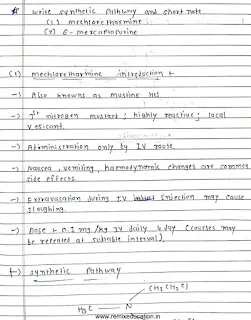Synthetic Pathway: Mechlorethamine and 6-Mercaptopurine
Keywords: Download PDF, Notes, PPT, Synthetic Pathway, Mechlorethamine, 6-Mercaptopurine, Nitrogen Mustards, Purine Antagonist
This document provides detailed information on the synthetic pathways of Mechlorethamine and 6-Mercaptopurine, including their methods of synthesis, chemical properties, and therapeutic applications.
Synthetic Pathway: Mechlorethamine and 6-Mercaptopurine
6-Mercaptopurine (6-MP)
IUPAC Nomenclature: 3,7-dihydropurine-6-thione
Methods of Synthesis
In the presence of tetraline as a solvent, hypoxanthine is heated along with an excess of phosphorous pentasulfide. These are heated at 200 °C for a few hours.
Purine Antagonist: 6-Mercaptopurine
- These are highly effective antineoplastic drugs.
- 6-Mercaptopurine is the thiol analog of hypoxanthine.
- 6-MP and 6-thioguanine were the first purine analogs to prove beneficial for treating neoplastic disease (Azathioprine, an immunosuppressant, exerts its cytotoxic effects after conversion to 6-MP).
- Purine antagonist used for the treatment of malignant diseases (mercaptopurine, thioguanine), but also for immunosuppression (azathioprine) and antiviral chemotherapy (acyclovir, ganciclovir, vidarabine, and zidovudine).
Nitrogen Mustards
- Mechlorethamine (Mustine HCl)
- Cyclophosphamide
- Ifosfamide
- Chlorambucil
- Melphalan
Ethylenimine
- Thio-TEPA
Alkyl Sulfonate
- Busulfan
Nitrosoureas
- Carmustine (BCNU)
- Lomustine (CCNU)
Triazine
- Dacarbazine (OTIC)
Mechlorethamine (Mustine HCl)
- Also known as Mustine HCl.
- First nitrogen mustard; highly reactive; local vesicant.
- Administration only by IV route.
- Nausea, vomiting, hemodynamic changes (acute effects) are common side effects.
- Extravasation during IV injection may cause sloughing.
- Dose – 0.1 mg/Kg IV daily * 4 days (courses may be repeated at suitable intervals).
Info!
If you are the copyright owner of this document and want to report it, please visit the copyright infringement notice page to submit a report.

